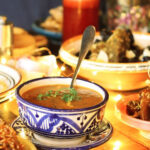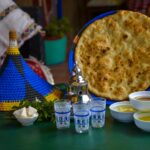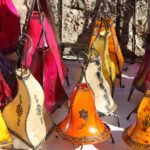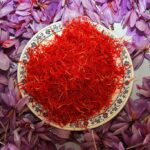CTRL+K
CTRL+K
During the Amazigh New Year celebrations, the Amazigh women take center stage in upholding treasured traditions that honor their community’s vibrant cultural legacy. One of the most cherished customs is the preparation of traditional dishes, a ritual that brings loved ones and neighbors together in a spirit of festivity and camaraderie. This practice serves as a heartwarming reminder of the Amazigh people’s deep-rooted connections to their heritage and their unwavering commitment to preserving their time-honored ways.
Women have long been the masterminds behind culinary creations in the kitchen. With their talented hands, they skillfully blend various ingredients to craft delicious meals that have been cherished for generations. Among these treasured dishes is the renowned “Tagoula,” a warm and comforting dish made from corn or barley semolina. Preparing Tagoula requires patience and a meticulous cooking process over gentle heat, ensuring that each grain is cooked to perfection.
According to the Berber traditions, Tagoula represents health, long life, and prosperity. Moreover, during the Amazigh New Year celebration, Tagoula is decorated with dates and almonds, with a date seed known as Amnnaz hidden within. Finding this seed is believed to bestow blessings upon the individual for the coming year.
Making Tagoula is more than just cooking – it’s a loving process steeped in cultural tradition. First, the semolina is carefully boiled until it reaches the perfect consistency. Then, delightful toppings are lovingly sprinkled over the warm semolina, each one adding its own special flavor. A drizzle of rich olive oil lends a luxurious taste. Or perhaps argan oil is preferred, providing a delightfully nutty essence. For those with a sweet tooth, a drizzle of honey offers a touch of sweetness. Indulgent melted butter takes the dish to a new level of decadence. And for an exotic flair, the unique Amlou – a delectable blend of almonds, honey, and argan oil – is an enticing option. With each carefully chosen topping, the flavors of Tagoula become more complex and satisfying.
Food in the Amazigh culture is much more than just something to eat. These traditional dishes are filled with deep meaning and symbolism that connect people to their roots, family, and community. Every bite is like tasting a piece of history that has been passed down for generations. Eating these foods is a way to honor the ancestors and the land they came from. These dishes act as a reminder to cherish family bonds, stay connected to others, and never forget where you came from.
When Amazigh families assemble around the dinner table, there is a powerful feeling of togetherness and inner strength filling the room. Even in today’s fast-paced world, the Amazigh people remain dedicated to upholding their cherished traditions and paying homage to their ancestors’ enduring cultural heritage. As they savor the flavorful traditional dishes, each bite serves as a reminder of their deep-rooted ancestry, a connection that fortifies their resolve to preserve their rich cultural identity. The unwavering spirit of the Amazigh people shines brightly, a beacon of resilience amidst the tides of change.





































There are no results matching your search.
Reset